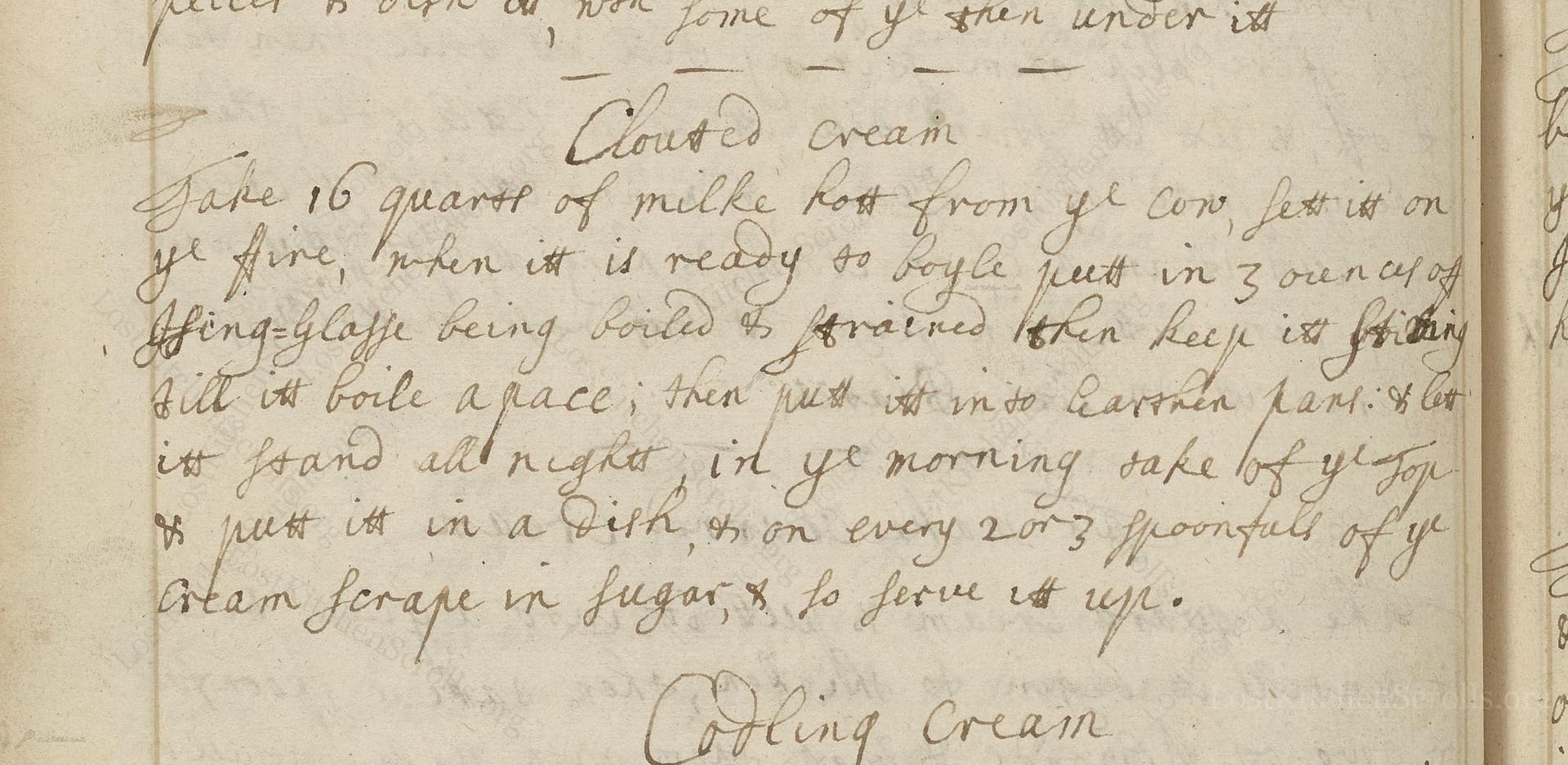Clouted Cream
From the treasured pages of Receipt book of Mary Hookes
Written by Mary Hookes

Clouted Cream
"Take 16 quarts of milke hott from ye Cow, sett it on ye fire, when it is ready to boyle putt in 3 ounces of Ising-glasse being boiled & strained then keep itt gently stirrd till it boile a pace; then putt itt into earthen pans: & let it stand all night, in ye morning take of ye top cream & putt it in a Dish, & on every 2 or 3 spoonfulls of ye cream scrape in sugar, & so serve itt up."
Note on the Original Text
This recipe is written in a direct, practical manner typical of manuscript cookbooks from the late 17th and early 18th centuries. Spellings are phonetic (e.g., 'boyle' for 'boil', 'ye' for 'the') and instructions rely on assumed knowledge of dairy handling. Quantities are large, reflecting a household scale of preparation, and descriptions are rooted in observational cues ('when it is ready to boyle', 'putt itt into earthen pans'), trusting the cook’s judgment. 'Ising-glasse' refers to a historic gelling agent made from sturgeon, here best replaced by modern gelatin. Despite its simplicity, the recipe is a testament to domestic ingenuity and the enduring allure of subtly sweetened cream.

Title
Receipt book of Mary Hookes (1700)
You can also click the book image above to peruse the original tome
Writer
Mary Hookes
Era
1700
Publisher
Unknown
Background
A delightful voyage into the kitchens of the late 17th and early 18th centuries, this book teems with forgotten flavors, aromatic recipes, and the elegant wisdom of early modern cookery. A treasure trove for culinary adventurers craving a taste of the past!
Kindly made available by
Folger Shakespeare Library
This recipe is drawn from the household book of Mary Hookes, compiled sometime between 1675 and 1725 in England. At that time, clouted (or clotted) cream was a luxurious treat, often served with sugar as a dessert or at the tea table. The recipe reflects a period when dairy was a central part of rural life, and making cream at home was both an everyday necessity and a sign of domestic skill. The inclusion of isinglass—a fish-derived gelling agent popular before the advent of modern gelatin—demonstrates the ingenious use of available resources to achieve desired textures. Serving sweetened clouted cream highlights the early modern taste for rich and sumptuous dairy dishes.

In Mary Hookes’s day, producing this recipe required a large cauldron or kettle for heating the milk directly after milking, a hot hearth or open fire for careful temperature control, and wide, shallow earthenware pans for setting the cream. A wooden or metal spoon would have been used for gentle stirring. Straining the isinglass would be accomplished through linen cloth or a simple sieve. For serving, an elegant dish and a special spoon would showcase the prized clouted cream at the table.
Prep Time
15 mins
Cook Time
30 mins
Servings
30
We've done our best to adapt this historical recipe for modern kitchens, but some details may still need refinement. We warmly welcome feedback from fellow cooks and culinary historians — your insights support the entire community!
Ingredients
- 4 gallons whole cow's milk (fresh, full-fat)
- 3 ounces leaf gelatin (to replace 3 ounces isinglass)
- Caster sugar, to taste (for serving)
Instructions
- To make clouted cream in the modern kitchen, begin by heating 4 gallons of fresh, full-fat cow's milk until it is just about to boil.
- While the milk heats, dissolve 3 ounces of high-quality leaf gelatin (as a substitute for isinglass, which is no longer commonly used) in hot water, then strain it to remove any solids.
- Once the milk reaches the scalding point, gently stir in the strained gelatin, making sure it fully dissolves.
- Maintain a gentle stir and allow the milk to reach a full boil, then transfer it into shallow wide ceramic or glass dishes.
- Let these dishes rest, uncovered, at cool room temperature or in the refrigerator overnight.
- Come morning, carefully skim the thick layer of clotted cream from the top.
- Serve the cream by placing it in a serving dish and, for every two or three spoonfuls, sprinkle a generous pinch of caster sugar across the top.
Estimated Calories
120 per serving
Cooking Estimates
You will spend about 15 minutes preparing the milk and gelatin, and about 30 minutes to heat and combine everything. The milk then needs to sit overnight in the fridge to allow the cream to set. Each serving is around 120 calories. This recipe makes about 30 servings.
As noted above, we have made our best effort to translate and adapt this historical recipe for modern kitchens, taking into account ingredients nowadays, cooking techniques, measurements, and so on. However, historical recipes often contain assumptions that require interpretation.
We'd love for anyone to help improve these adaptations. Community contributions are highly welcome. If you have suggestions, corrections, or cooking tips based on your experience with this recipe, please share them below.
Join the Discussion
Rate This Recipe
Dietary Preference
Main Ingredients
Occasions

Den Bockfisch In Einer Fleisch Suppen Zu Kochen
This recipe hails from a German manuscript cookbook compiled in 1696, a time whe...

Die Grieß Nudlen Zumachen
This recipe comes from a rather mysterious manuscript cookbook, penned anonymous...

Ein Boudain
This recipe comes from an anonymous German-language manuscript cookbook from 169...

Ein Gesaltzen Citroni
This recipe, dating from 1696, comes from an extensive anonymous German cookbook...
Browse our complete collection of time-honored recipes



